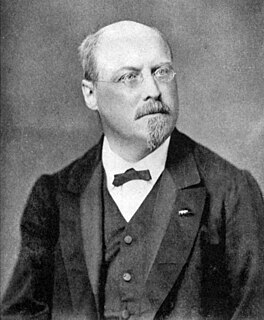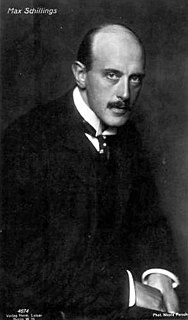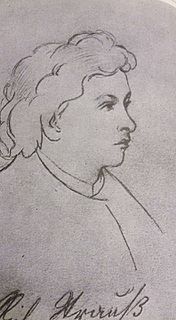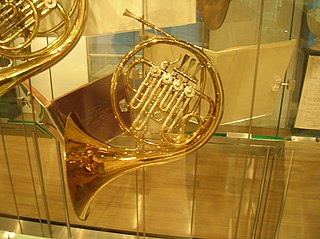
Richard Georg Strauss was a German composer, conductor, pianist, and violinist. Considered a leading composer of the late Romantic and early modern eras, he has been described as a successor of Richard Wagner and Franz Liszt. Along with Gustav Mahler, he represents the late flowering of German Romanticism, in which pioneering subtleties of orchestration are combined with an advanced harmonic style.
This article is about music-related events in 1880.

Joseph Joachim Raff was a German-Swiss composer, pedagogue and pianist.

Erich Wolfgang Korngold was an Austrian composer and conductor who, having lost his Austrian nationality, adopted US citizenship. A child prodigy, he became one of the most important and influential composers in Hollywood history. He was a noted pianist and composer of classical music, along with music for Hollywood films, and the first composer of international stature to write Hollywood scores.

Franz Joseph Strauss was a German musician. He was a composer, a virtuoso horn player and accomplished performer on the guitar, clarinet and viola. He was principal horn player of the Bavarian Court Opera for more than 40 years, a teacher at the Royal School of Music, Munich, and a conductor.

Jan Walter Susskind was a Czech-born British conductor, teacher and pianist. He began his career in his native Prague, and fled to Britain when Germany invaded the city in 1939. He worked for substantial periods in Australia, Canada and the United States, as a conductor and teacher.

Max von Schillings was a German conductor, composer and theatre director. He was chief conductor at the Berlin State Opera from 1919 to 1925.

Ludwig Wilhelm Andreas Maria Thuille was an Austrian composer and teacher, numbered for a while among the leading operatic composers of the so-called Munich School of composers, whose most famous representative was Richard Strauss.

Hans von Koessler was a German composer, conductor and music teacher. In Hungary, where he worked for 26 years, he was known as János Koessler.
Edvard Grieg composed the Cello Sonata in A minor, Op. 36 for cello and piano, and his only work for this combination, in 1882–83, marking a return to composition following a period when he had been preoccupied with his conducting duties at the Bergen Symphony Orchestra as well as illness.
Philip Fowke is an English pianist.

The Burleske in D minor is a composition for piano and orchestra written by Richard Strauss in 1885-86, when he was 21.

The Symphony No. 2 in F minor was written by Richard Strauss between 1883 and 1884. It is sometimes referred to as just Symphony in F minor. He gave it the Opus number 12, and it also appears in other catalogues as TrV 126 and Hanstein A.I.2. It is not listed in von Asow's catalog.

Benno Walter was a German violinist and teacher, who had associations with Richard Strauss and his family, to whom he was closely related, and also with Richard Wagner.
In 1882–3 Richard Strauss wrote his Horn Concerto No. 1 in E-flat major, Op. 11, in two versions, one for piano accompaniment and one with an orchestra. The horn concerto has become the most frequently performed horn concerto written in the 19th century.The premiere with piano accompaniment was given in 1883 at Munich. The premiere with orchestral accompaniment in 1885 at Meiningen.

Richard Strauss composed his Symphony No. 1 in D minor in 1880 when he was just 16 years old. It consists of four movements, and lasts about 34 minutes. Although Strauss did not give a number to the symphony, it is often referred to as his First Symphony. It was premiered on 30 March 1881 at the Munich Academy of Music under the baton of Hermann Levi.

Richard Strauss composed his Cello Sonata in F major, Op. 6, TrV 115, in 1883 when he was 19 years old. It was dedicated to the Czech cellist Hanuš Wihan, who gave the premiere in 1883. It rapidly became a standard part of the cello repertoire.

Nándor Zsolt was a Hungarian violinist, conductor, composer and the professor of violin at the Franz Liszt Academy of Music.

Richard Strauss composed his Horn Concerto No. 2 in E-flat major, whilst living in Vienna in 1942. The work was premiered in 1943 at the Salzburg Festival and was recorded in 1944, both with solo horn Gottfried von Freiberg. The score was published by Boosey & Hawkes of London in 1950. It was taken up and popularised by the British horn player Dennis Brain. It has since become the most performed and recorded horn concerto of the 20th century.
The Duet-Concertino for clarinet and bassoon, TrV 293, with string orchestra and harp in F major, was written by Richard Strauss in 1946/47 and premiered in 1948. It is the last purely instrumental work he wrote.
















